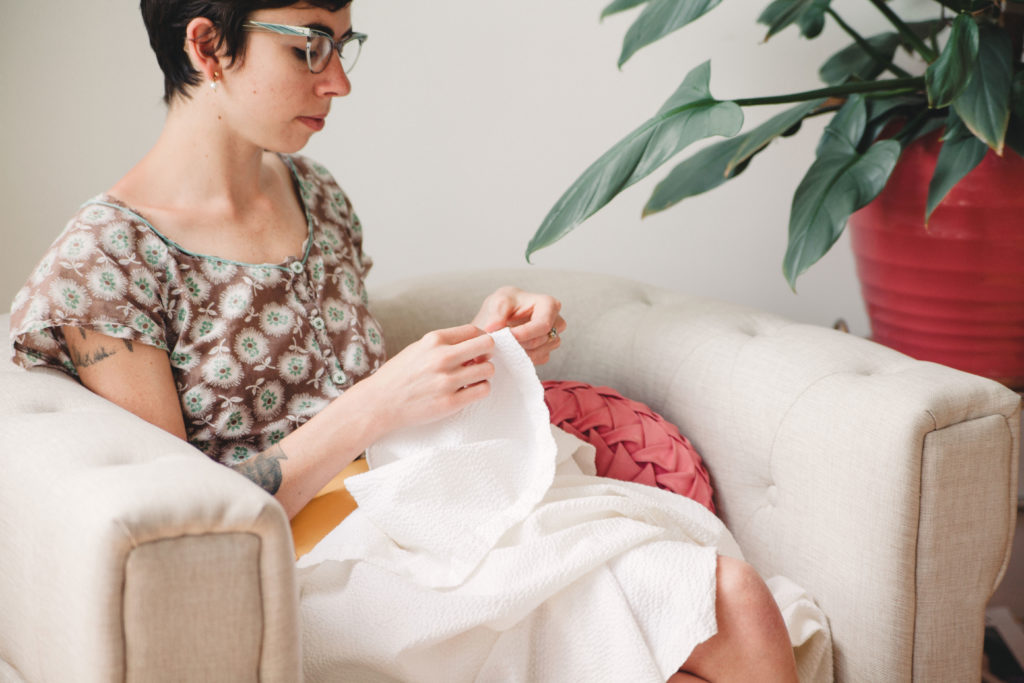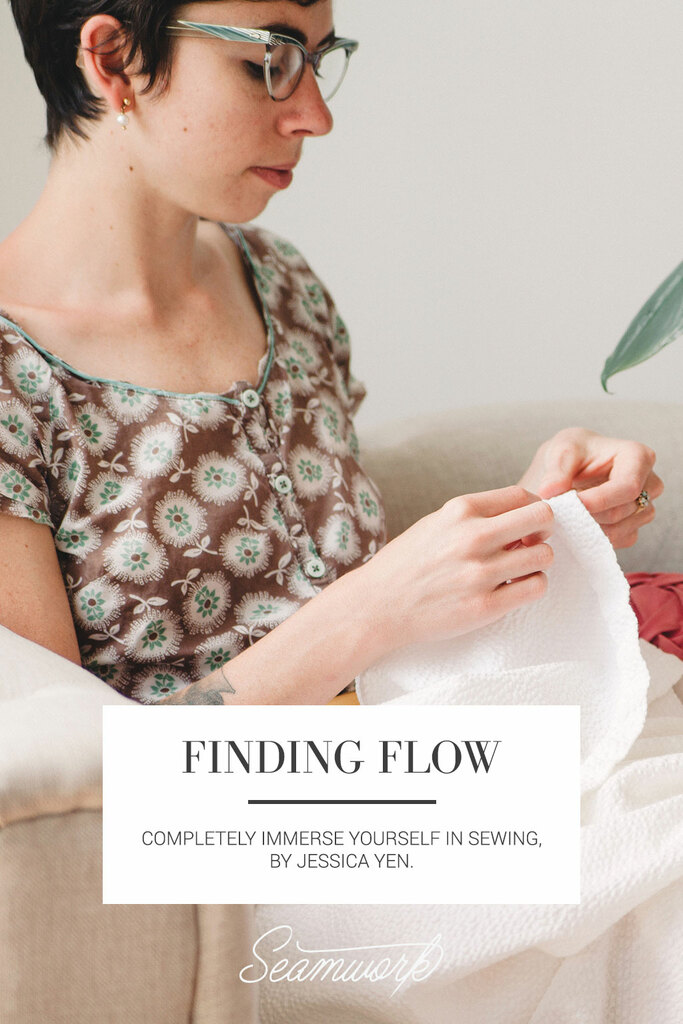Have you ever lost yourself in a sewing project, becoming so immersed that when you finally look up you realize hours have slipped by? If so, you have experienced what scientists call flow. Flow occurs when you are completely absorbed in an intellectual, creative, or physical activity. More importantly, it is correlated with happiness, so much so that the psychologist Mihaly Csikszentmihalyi, a pioneer of the study of flow, has described it as a key element for happiness.
The Elements of Flow
Csikszentmihalyi, a Hungarian psychologist spent time in an Italian prison camp during World War II. Toward the end of the war, he noticed that playing chess or reading a good book allowed him to leave behind the misery of his environment. He went on to study psychology, where he conducted research on flow, becoming one of the founders of the positive psychology movement.
Flow is associated with a number of pursuits, like the athlete who “gets into the zone” or the writer who reaches the moment when everything clicks. But flow can occur while you’re deep into conversation with a good friend. Flow is a space in time where you become so involved in the activity at hand that you act effortlessly, experiencing a heightened awareness of the present.
Csikszentmihalyi described flow as “being completely involved in an activity for its own sake. The ego falls away. Time flies. Every action, movement, and thought follows inevitably from the previous one, like playing jazz. Your whole being is involved, and you’re using your skills to the utmost.”
Activities that elicit flow should be enjoyable to you, perceived as voluntary, require some level of skill (but not exceed your current skill level), and have clear goals towards success. Also, you must receive clear feedback on your progress, such that there is room for growth. Finally, you need to feel like you have control.
In many ways, sewing is an excellent candidate for inducing flow. For many of us, it is a voluntary activity with an unending scaffold of skills to learn and master. Sewing projects are inherently broken into a series of clear goals, with plenty of feedback along the way. And for many of us, sewing is the place in our life where we experience the greatest sense of control.
In a world filled with distractions, it’s important to preserve an island of sanity for ourselves. Regularly entering into flow can help us increase our powers of concentration, improve our self-esteem, and enhance both our skills and our execution.
Although Csikszentmihalyi’s first experiments occurred in the 1970s, scientists have only recently begun piecing together the neurological basis for this phenomenon. In addition to providing a fascinating glimpse into our minds, this body of science also suggests ways that we can enhance our ability to enter into flow as we sew.

The Science behind Flow
When you’re in a state of flow, you turn off the part of your brain that produces distracting thoughts—like your to do list, or the voice that criticizes your attempts to try something new. This part of the brain is the frontal cortex, which houses most of our higher cognitive functions, including our sense of self. Having a large prefrontal cortex is one thing that separates humans from other animals. This ability for self-awareness and self-analysis also fuels our inner critic. For sewists who struggle with perfectionism, the prefrontal cortex can hamper more than help.
When you get into a state of flow, you experience transient hypofrontality, whereby the frontal cortex temporarily quiets down. This inner critic stops micromanaging and commenting on every decision. This transient hypofrontality is also responsible for that feeling of losing yourself in a project, because your perception of yourself as distinct from the outside world diminishes.
Furthermore, when you’re in a state of flow, there’s an increase in specific neurotransmitters that help you sustain that state. Increased levels of norepinephrine, for example, create a form of tunnel vision by narrowing our focus, allowing us to get deep into the activity at hand. Dopamine allows us to direct our attention and then sustain our focus on specific neural pathways. This may also be why it takes a little bit of time to get into a state of flow: our behaviors (like focus and attention) trigger the release of these neurotransmitters, helping us to then sustain these behaviors (producing sustained concentration). This is also why, at the beginning of a session when distractions abound (popping up to make a snack, tending to our family’s requests), it can be important to keep our attention on the project at hand, where possible, to give those neurotransmitters time to kick in.
Bringing Flow into the Sewing Room
Let’s look at four fundamental components of flow. Being aware of these elements will help enhance flow in your creative projects.
One: match your skills to the project’s challenges
It’s important to select projects with the right amount of stretch. Too much challenge generates frustration but too little challenge creates boredom, and neither is good for flow. Ideally, look for projects where you learn one to two new techniques at most (this includes trying out a new fabric). Or if you’re using a TNT pattern, counteract boredom by using a tricky fabric, testing a new construction method or finishing technique, or adding special details. This is true for school as well; studies have found that classrooms benefit from flow when teachers match assignments to student abilities.
Two: set a clear goal
Sewing has a tangible goal built into every project: a finished object. However, this is just one of many goals you could set. If you use sewing as a personal ritual, for example, setting an intention at the start of a session creates a non-tangible goal for yourself, like staying present. Your goal might also relate to technique: install a lapped zipper for the first time, improve the quality of your buttonholes. Or you may wish to focus on the crafting process. Cultivating patience, slowing down, and decreasing perfectionism are other types of intangible goals.
Three: check-in with yourself
Create constant and immediate feedback on progress towards your goal. This is really two steps: identifying the form feedback will take, and then being mindful of your progress throughout your session. For tangible goals, don’t just fixate on finishing. Checklists are a great way to mark progress. You can also think of your garment in chunks; today I prepped the bodice, I’ve finished everything but the hems. Pausing at the end of a new technique is a great opportunity to reflect on what you’ve learned and to celebrate adding another skill to your arsenal. For intangible goals, you can you check in with yourself at the end of the session or create small breaks throughout.
Four: reduce environmental distractions
Free yourself to fully concentrate. Minimizing distractions is crucial for entering a state of flow. For those of us who do not have the luxury of a dedicated crafting space, this might require some creativity. Try setting up your machine in a spot that is away from the main hub of activity, or finding times in the day when fewer people are around. However, minimizing distractions also relates to how quickly one enters a state of flow. Know your common distraction triggers and figure out ways to decrease them. For instance, keeping all project-related notions, trims, fabrics, and instructions in one place can help.
I like to store my commonly-used sewing tools in a silverware basket so that I can just grab-and-go when I craft. For those with limited time, Lauren Taylor of the sewing blog Lladybird also suggests fitting your sewing to the time you have (like skipping ahead to sew a collar or sewing and pressing all darts at once). The advantage of this approach is that it automatically divides your project into manageable chunks, creating a micro-goal with immediate feedback.
Whether you regularly enter into flow while sewing or are seeking to use sewing to enter into flow more frequently, understanding the science behind the phenomenon can enhance our appreciation and experience of the art of sewing. Keep in mind the fundamental elements of flow the next time you set out to sew. These principles will act as keys to help you unlock the benefits of this state.


